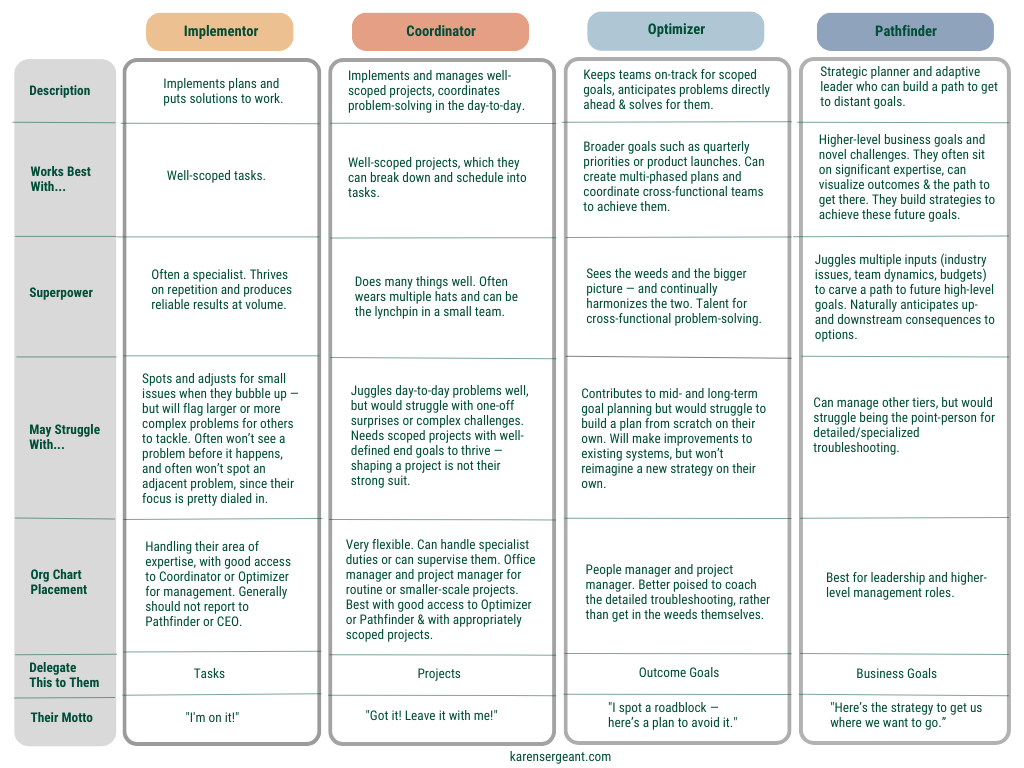Close your eyes and give me description of your dream team member.
Let me guess, it goes something like this:
Works independently when given a higher-order goal, breaks down big projects into smaller parts, anticipates problems and steers us out of danger before it happens, is flexible enough to jump in and help OR to manage others — and has the ability to perform detailed work steadily and repeatedly without fatigue...or errors!
Me too, reader. Me too.
And although we don't really expect ALL of those qualities to show up in one complete package, we can harbor unrealistic expectations about what we want to see, even in a superstar.
The thing is — some of those qualities are mutually exclusive. It would be highly unlikely to see some of them combined into one person. Even a team member who is "well-rounded" will show a much stronger aptitude for some of these attributes and not others.
The Well-Rounded Team Member
Let's talk about this "well-rounded" team member for a second. They are the life-blood of small teams — the ones we count on to wear multiple hats and sit in multiple places in the org chart. Many have been with us from the very beginning and are the person we can count on whenever we're in a pinch.
And — their roles often are the first to become problematic when a small team begins to add headcount.
To be clear: they don't become problematic. But finding their best place in the org chart can be a little tricky — especially if we haven't unpacked their true strengths.
When team members wear multiple hats, they are also in multiple places in the org chart and on multiple levels of the org chart — manager, supervisor, implementor — but are usually excelling at only one of those levels. But which one?
These are the questions I help clients unpack and solve every week. And because this can be a tricky lock to pick (particularly when everyone has been buried under mounds of work that can obscure what the strengths and struggles really are) I've created a continuum that maps 4 archetypes — I call them Worketypes™️ because I like to sound clever. Each Worketype can be described in terms of the “shape” of its corresponding skills and struggles. Have a look. (Click the chart to enlarge.)
The 4 Worketypes™️

For many business owners, this table can spark some major aha's about team members who have been underperforming — or so they've thought — when really it's because the team member has too many duties and responsibilities that work against type.
It also provides a map of sorts to guide us to creating the type of team (through org chart adjustments and strategic hiring) where each member can do their best work.
Seeing the Worketypes in Action
This scenario illustrates what agreement and pushback would sound like from the 4 types — in a realistic scenario.
Overall Scenario: Planning an upcoming launch. The goal is to move 50 units and the cart opens at end of October
Pathfinder (as a FB Ads expert)
- Agreement sounds like: Great, let me run an audit of your assets and give me access to your ads manager and I’ll come back with a plan. Ok, here’s the plan: I’ve noticed that webinars are dead and 5-day Challenges are what’s resonating, so this is what the funnel should look like to get what you want. The ads budget will need to be $x to make those goals. Here’s my scope of work, and my fee.
- Pushback sounds like: If you really want stick with a webinar, your ad spend will be 2x to produce the same results, or we’ll need to adjust that unit goal down.
Optimizer (as a Launch Manager)
- Agreement sounds like: Great, let me go pull the metrics of our previous launches — I’ll set up a doc of what we’ve done previously and the results its produced. Once we’ve digested that, let’s call a meeting to sift through all the options and you can make your decisions of what’s in/out. Once you’ve nailed down all the moving parts, I’ll get everyone organized!
- Pushback sounds like: (During the Kick-Off meeting) I don’t think there’s enough runway for that. It’s more complex than it sounds, and to really pull it off, we’ll need either more people or more time. Here’s an alternative...
Coordinator (as an Tech Specialist)
- Agreement sounds like: Great, remember I’ll need 10 days to create the automations, load, link & test all the emails. So I’ll need that copy finalized and to me by 10/15.
- Pushback sounds like: Remember last time I didn’t get enough runway and was still building as we were launching? That meant we couldn’t implement anything creative in response to what we were seeing. Let’s not do that again.
Implementor (as a Tech Specialist)
- Agreement sounds like: Great, I’ve blocked off a lot of October to have time to work on this. Let me know what you need.
- Pushback sounds like: There’s too much work all due at the same time — and when I’m this rushed, I know that errors will creep into my work. (Also, why does it always come down to me?! All this rushing is because others didn’t plan better or make up their minds in time!)
The Take-Aways
As business owners, team-builders, (and Team Growth Strategists), we want to keep in mind:
1️⃣ There is no type that is "better" than another. Team members do not become more valuable as they "go right" on the chart. Think about a restaurant. Line cooks make the food that go in people's mouths — the primary factor in whether a customer enjoyed the meal or not. It doesn't get any more mission-critical than that. Frequently, the can't-live-withouts fall more on the left side of the chart.
2️⃣ You can have all four types in your org chart — but you don't necessarily need all four. There's no templated recipe for this. It's a combination of what you make & sell, who you have on your team, your budget, what strengths you-as-business-owner bring to the table — and what's left over. Hit me up if you have a team situation you want to workshop.
3️⃣ We need to make room for each type to work in their strengths. This means acknowledging the kind of guidance they work best under, supplying it — and matching job duties to strengths. Without wishful thinking, finger-pointing, or delusion. This is what next-level business looks like. Welcome to the party.
📲 Formatted for Mobile: The table information, section by section
⚙️ Quick Descriptions
Implementor: Implements plans and puts solutions to work.
Coordinator: Implements and manages well-scoped projects, coordinates problem-solving in the day-to-day.
Optimizer: Keeps teams on-track for scoped goals, anticipates problems directly ahead & solves for them.
Pathfinder: Strategic planner who can build a path to get to distant goals.
👩🏾💻 Works Best With...
Implementor: Well-scoped tasks.
Coordinator: Well-scoped projects, which they can break down and schedule into tasks.
Optimizer: Broader goals such as quarterly priorities or product launches. Can create multi-phased plans and coordinate cross-functional teams to achieve them.
Pathfinder: Higher-level business goals and novel challenges. They often sit on significant expertise, can visualize outcomes & the path to get there. They build strategies to achieve these future goals.
🦸🏻 Superpowers
Implementor: Often a specialist. Thrives on repetition and produces reliable results at volume.
Coordinator: Does many things well. Often wears multiple hats and can be the lynchpin in a small team.
Optimizer: Sees the weeds and the bigger picture — and continually harmonizes the two. Talent for cross-functional problem-solving.
Pathfinder: Juggles multiple inputs (industry issues, team dynamics, budgets) to carve a path to future high-level goals. Naturally anticipates up- and downstream consequences to options.
🤦🏻 May Struggle With...
Implementor: Spots and adjusts for small issues when they bubble up — but will flag larger or more complex problems for others to tackle. Often won’t see a problem before it happens, and often won’t spot an adjacent problem, since their focus is pretty dialed in.
Coordinator: Juggles day-to-day problems well, but would struggle with one-off surprises or complex challenges. Needs scoped projects with well-defined end goals to thrive — shaping a project is not their strong suit.
Optimizer: Contributes to mid- and long-term goal planning but would struggle to build a plan from scratch on their own. Will make improvements to existing systems, but won’t reimagine a new strategy on their own.
Pathfinder: Can manage other tiers, but would struggle being the point-person for detailed/specialized troubleshooting.
👩🏻🤝👨🏿 Best Place in the Org Chart
Implementor: Handling their area of expertise, with good access to Coordinator or Optimizer for management. Generally should not report to Pathfinder or CEO.
Coordinator: Very flexible. Can handle specialist duties or can supervise them. Office manager and project manager for routine or smaller-scale projects. Best with good access to Optimizer or Pathfinder & with appropriately scoped projects.
Optimizer: People manager and project manager. Better poised to coach the detailed troubleshooting, rather than get in the weeds themselves.
Pathfinder: Best for leadership and higher-level management roles.
👩🏽⚖️️ Delegate This to Them...
Implementor: Tasks
Coordinator: Projects
Optimizer: Outcome goals
Pathfinder: Business goals
🗣️ Their Motto...
Implementor: “I'm on it!”
Coordinator: “Got it! Leave it with me.”
Optimizer: "I spot a roadblock — here’s a plan to avoid it."
Pathfinder: "Here’s the strategy to get us where we want to go.”
Thank you for reading! Let me know what you think of it.








Member discussion